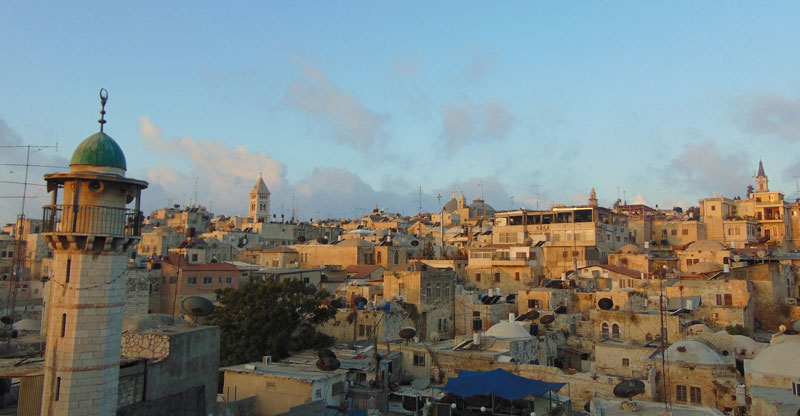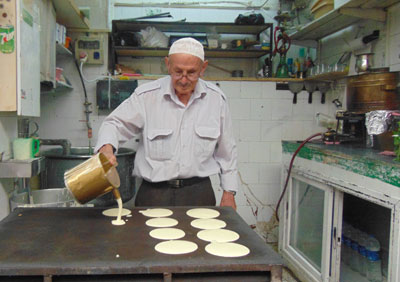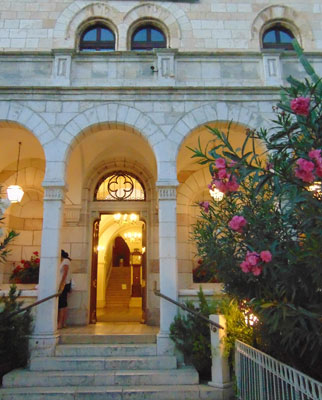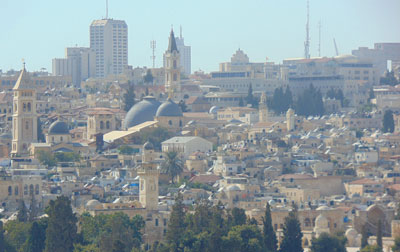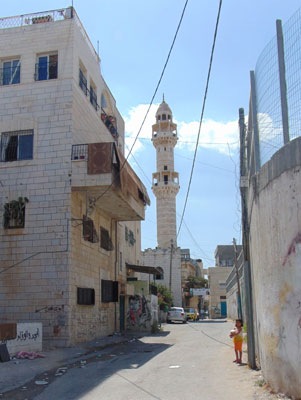An enlightening visit to the West Bank
This article appears on page 42 of the May 2016 issue.
Traveling with another couple with whom we have been friends for many years and who share our enthusiasm for travel and adventure, we took Oceania Cruises’ “Jewels of the Aegean” in early September 2015. The cruise included a 2-day stopover in the port of Haifa, Israel, located approximately 100 miles north of Jerusalem.
To make the most of the short period we would be in Israel, we developed a list of sites we wanted to visit and activities we wanted to accomplish. The real challenge was to prioritize this list to fit the 2-day time frame.
Our list included many of the popular places of interest, but, more importantly, we wanted to tour the Palestinian West Bank, visit a Palestinian refugee camp and speak with as many local people as possible.
It became quite apparent early in the planning process that the standard tour offered by the cruise line and other major tour companies would not meet our requirements. We needed a tour company that catered to small, private groups and would be willing to customize an itinerary.
Making plans
We eventually narrowed our search to three tour companies based in Israel and provided each with our desired itinerary, the activities that we wanted included and our transportation needs.
We received responses with price quotes from all three tour companies and, after a thorough review, selected Breaking Bread Journeys as the best fit. Breaking Bread Journeys (East Jerusalem; phone +1 [561] 910 0640, breakingbreadjourneys.com) was formed in 2010 by Elisa Moed and Christina Samara, who shared the concept of promoting economic development through tourism. They believe that with cooperative efforts, the service industry is a path to better understanding, peace and stability in the region.
Lazarus Kevorkian was assigned as our tour guide for this adventure. He is an independent, professionally licensed guide who is fluent in Armenian, Hebrew, Arabic and English.
Lazarus met us as we disembarked from the ship early on a Sunday morning (Sept. 20). We spent the entire 2-hour drive south from Haifa to Jerusalem questioning him about the Israeli economy, politics, security, religion, relationships between the Muslim, Jewish and Christian communities, etc.
The more we shared our own personal perspectives with him, the more comfortable he became with us, and no subject was off limits. Throughout our two days of touring, we found Lazarus to be open, honest, enthusiastic, extremely caring and very knowledgeable about his country, its culture and its people. He was one of the best guides we have had in our 40 years of international travel.
Security
We passed through our first (of many) Israeli security checkpoints prior to entering the West Bank. Based on TV media reports in the US, we expected that passing through these security points would be time consuming and possibly difficult. However, we crossed back and forth as one would travel through a toll gate on a turnpike.
Lazarus explained that vehicles that have Israeli license plates usually do not encounter any difficulties, but if a vehicle has a Palestinian license plate, it is subject to being stopped and searched.
Before we arrived at our first stop, we were greeted by a huge red sign written in Arabic, Hebrew and English: “This road leads to Area ‘A’ Under the Palestinian Authority. The entrance for Israeli citizens is forbidden, dangerous to your lives and is against the Israeli law.”
Well, that catches your attention!
For the most part, Palestine is a territory occupied and controlled by another country (Israel). The Oslo Accord of 1995 created three temporary distinct administrative divisions within the Palestinian territories (specifically, the West Bank), designated as Areas A, B and C. These three temporary divisions remain today, more than 20 years later.
The areas are not contiguous but are fragmented. Area A is under the control of the Palestinian Authority. It comprises 18% of the West Bank. This area includes Palestinian cities and surrounding areas where there are no Israeli settlements.
Area B is under civil control of the Palestinian Authority, with security control exercised jointly by the Palestinian Authority and Israel. Comprising 20% of the West Bank, this area includes many Palestinian towns and villages where there are no Israeli settlements.
Area C is under full Israeli civil and security control. It comprises 62% of the West Bank. This area includes all Israeli settlements (cities, towns and villages), nearby land and most roadways that connect the settlements, in addition to strategic areas described as “security zones.” There were 1,000 Israeli settlers living in Area C in 1972; by 2012, the Israeli population had increased to more than 300,000. The current Palestinian population in this area is also about 300,000.
Throughout our travels in the West Bank, we were forever conscious of the Israeli security wall with its electronic monitoring devices and security watchtowers. Driving along the highways from one Israeli city/settlement to another with the high-security walls on either side of the roadway, at times it felt as if we were traversing a toboggan run.
Refugee camp visit
Our first stop on the tour was the Aida Palestinian refugee camp, located on the northern outskirts of Bethlehem. Breaking Bread Journeys arranged for us to meet with Dr. Abdelfattah Abusrour, founder and managing director of Alrowwad, an independent nonprofit organization housed within the camp.
Alrowwad was established in 1998 by a group of volunteers who believed that, by fostering creativity and nonviolent self-expression, each person has the potential to be a change-maker. Alrowwad provides educational and vocational training and works on building peace opportunities within the community and within individuals so they are able to inspire other Palestinians.
We spent over an hour speaking with Dr. Abusrour. He eloquently provided a description of the historical conflict between the Palestinians and Israel over the past century. He shared what it’s like to exist in a society where an individual does not have the privileges and rights normally afforded its citizens and expressed the difficulty of surviving in a land that continues to shrink due to the expansion of Israeli settlements.
Following our discussions with Dr. Abusrour, we took a brief tour around the camp. It was established in 1950 to house Palestinian refugees who were displaced from their villages following the 1948 Palestine war. The current population of the camp is approximately 5,000. We wondered, aside from the efforts of Alrowwad, what else was being done to encourage and assist these families in finding permanent housing, placement and employment beyond the camp.
The general appearance of the camp was depressing and the feeling, one of despair. In our opinion, it was unkempt, with litter and debris everywhere.
The high concrete security wall formed the outer boundary of the camp on one side and was very much in evidence. On the Palestinian side, the wall was covered with graffiti that some might say was artwork, representing the frustration and despair of the camp’s residents.
Bethlehem
After leaving the Aida refugee camp, we had lunch at a restaurant in Bethlehem that provided a taste of authentic Palestinian cuisine and a chance to reflect and discuss our camp visit. The restaurant was filled with patrons, and it appeared that we were the only non-Palestinians there.
After a delicious and filling lunch, we proceeded to Manger Square and the Church of the Nativity in the heart of Bethlehem. Immediately, what caught our attention was the enormity of the complex, which is comprised of two churches (the Church of the Nativity and the Church of Saint Catherine) and an underground crypt, the Grotto of the Nativity. The complex is administered jointly by Greek and Armenian Orthodox authorities and Roman Catholics.
The grotto lies beneath the Church of the Nativity, where, tradition says, Jesus was born. The site is marked by a 14-point star. Another altar marks the site where it is said that Mary laid the newborn child in the manger.
During our visit, a service was being held in the basilica on the main floor, so, unfortunately, we were not able to explore that facility.
We were very impressed with the simplicity of the interior of the Church of Saint Catherine, where the Christmas Eve midnight Mass is celebrated annually and televised worldwide. The entire complex was truly a splendid site and well worth a visit.
Jericho
From Bethlehem we preceded to Jericho, approximately 6 or 7 miles from the Dead Sea (which you can see off in the distance as you approach the city).
Nancy had read about Tell es-Sultan, an archaeological site that displays the remains of ancient Jericho and the “civilization of hunter-gatherers” who settled in this area around 9,000 BC. Pulling into the parking lot, we were greeted by a group of peacocks and the lovely Elisha’s Spring (aka Elisha’s Fountain), with a sign labeling the site “The Oldest Town in the World!”
Lazarus explained, “There is no doubt this archaeological site is of some significance, but in reality there is not much to see except a mound of dirt with a few walls, a fortification system and a tower.”
It was getting late and we all were feeling the effects of our very busy day, so we decided to forgo taking a tour of the site. Instead, Lazarus took us to a picturesque spot, where we had a panoramic view of the Mount of Temptation. We enjoyed the view with a glass of fresh pomegranate juice purchased at a small stand and wished we had the time and energy to hike up to the Greek monastery precariously situated on the top of the Mount of Temptation.
We made one more stop at a produce stand, where we bought fresh dates that we thoroughly enjoyed on the drive back to Jerusalem.
Driving through the Jordan Valley, we saw large stretches of desert and Bedouin camps of goat herders, which helped make the drive back to Jerusalem more enjoyable.
Staying in the city
Once we arrived in Jerusalem that evening, Lazarus dropped us off at the Damascus Gate, one of the main entrances to the Old City. Vehicle traffic is prohibited in this area, hence the need for us to walk the short distance to the Via Dolorosa, where we were staying.
While planning for our trip, we received a recommendation from an ITN subscriber suggesting that we stay at the Austrian Hospice of the Holy Family (Via Dolorosa 37; austrianhospice.com), located in the Muslim Quarter of the Old City. Breaking Bread Journeys would have arranged our lodging, but we decided to stay at the hospice and made the arrangements, ourselves.
The Austrian Hospice of the Holy Family has existed in Jerusalem’s Old City since the mid-19th century and is one of few facilities in that area to provide overnight accommodations for visitors. Within its large, sturdy walls were lovely gardens and quiet spots to sit and relax.
The cost per night for one room for two people, including a full breakfast, was $153. The hospice only accepts cash payments in either US dollars, euros or Israeli shekels (no credit cards).
After checking into the hospice, we found our room to be clean and spacious but without air-conditioning, and Jerusalem was experiencing a very hot September! Luckily, each room had an oscillating fan, and we were able to open the massive windows to get a limited air flow. The view from the window was spectacular!
After freshening up, we headed downstairs to the Viennese Café & Coffee House for dinner. We had goulash soup, salad, bread and wonderful Austrian beer, ending the meal with apple strudel. The total meal cost less than $20 per person. All this was enjoyed in the charming garden outside the café.
We were very tired after a full day of touring and mind-boggling cultural experiences. The cool garden setting invited us to linger awhile and enjoy the cool night breezes.
Old City sights
The first item on the itinerary for the next morning was a visit to the Temple Mount, a most sacred site to both Jews and Muslims. Lazarus met us with the greeting, “My friends, today is a day to be wise rather than foolish!” He proceeded to tell us of recent violent conflicts* at the Temple Mount and suggested, for safety reasons, we avoid visiting the site. We trusted Lazarus’ wisdom and decided to heed his advice, forgoing our planned visit.
After leaving the hospice, we walked the path of the Stations of the Cross along the Via Dolorosa, stopping at each station and receiving an explanation and history of the site, ending at the Church of the Holy Sepulchre, situated on what is said to be the location of Christ’s crucifixion and burial.
From there, we toured various parts of the Old City, including the Western Wall, Mount Zion, King David’s Tomb and the hall where it is believed the Last Supper was held. We even witnessed a young man’s Bar Mitzvah procession.
Lazarus then announced, “Now I show you where the locals do their shopping,” and he led us through the backstreets into the market area. We passed the butcher shop, the fish market and the vegetable vendor selling colorful produce. Each merchant greeted Lazarus by name and welcomed us into their shop.
We concluded the day by returning to the West Bank for our last and final stop on the itinerary, the lovely home of Iman, a Muslim Palestinian woman who also works with Breaking Bread Journeys. Iman, her mother and her high-school-age daughter welcomed us into their home with warm sincerity.
Our visit started with tea and conversation, during which we could openly ask questions. Iman then served a lovely, delicious meal of chicken and rice.
We found the family to be very open and willing to discuss and share their lives and experiences living in Palestine. It was an absolutely delightful way to spend an afternoon and conclude our tour of Jerusalem and the Palestinian West Bank.
Though we were quite tired after two full days of touring, we used the 2-hour drive back to Haifa to continue our discussion with Lazarus, sharing our observations from the tour. He was an excellent and patient tour guide.
Looking back
It would be difficult to travel to this region of the world and not ask the question “Is there any hope for peace in this region during our lifetime?” We asked this very question to everyone we had the opportunity to speak with during our brief visit. Unfortunately, the unanimous response we received from all was “We have hope but don’t think peace is obtainable.”
Would we do this adventure again? Absolutely, without any doubt! It is an experience we will reflect upon over and over again.
The total cost for our party of four was $2,080. This covered all transportation, our English-speaking guide and driver for two days, lunches and all parking and admission fees. Based on the quality of service we received from Breaking Bread Journeys, we believe the cost was well worth the experience.
*Within days of our returning to the US, we received an email from Lazarus stating that “A Palestinian stabbed to death two Jewish civilian worshipers just in front of the Austrian Hospice, where you spent a night. He was shot dead by the police. The last couple of days witnessed a lot of tension between both sides.”
Each day following Lazarus’ email, BBC News reported incidents of violence and retalitory killings on the streets of Jerusalem from both sides of the conflict. Will it ever end?

